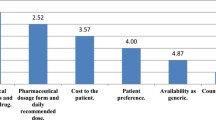Abstract
Introduction
Efforts to restrain pharmaceutical costs in the Norwegian hospital sector have focused on putting pharmaceuticals out to tender with resultant frequent changes in medicine inventories. Due to the extent of physicians failing to prescribe from the hospital drug list, the nurses have to perform generic substitution on the wards. The objective of the present study is to investigate the hospital nurses’ experiences with generic substitution and to explore their views on this strategy as a risk factor for medication errors.
Methods
Personal interviews with 100 nurses who were employed in a large Norwegian hospital were conducted using a semistructured questionnaire.
Results
In all, 75% of nurses thought it was problematic that the hospital’s drug inventory was subject to frequent changes, and 91% believed that the high number of generic products may contribute to erroneous dispensing. Nevertheless, three out of four admitted that they seldom or never verified the feasibility of the substitution with the physician, and that it was seldom documented in the medical charts. In total, 42% of the nurses had experienced mistakes that occurred as a result of substitution. They claimed that the medication errors relating to generic substitution derived from difficult drug names, frequent changes in the drug inventory, and the increasing number of generic drugs, as well as from heavy workload and insufficient training.
Conclusions
The present study shows that generic substitution is often carried out by nurses on the wards. The nurses feel insecure about the situation and report that they do not have the necessary training for the task. They clearly believe that a high number of generic drugs and frequent generic substitutions are risk factors for medication errors. Hence, hospital managers should be aware that such strategies to reduce costs may interfere with patient safety.
Similar content being viewed by others
References
Ess SM, Schneeweiss S, Szucs TD. European healthcare policies for controlling drug expenditure. Pharmacoeconomics. 2003;21:89–103.
Håkonsen H, Horn AM, Toverud EL. Price control as a strategy for pharmaceutical cost containment — what has been achieved in Norway in the period 1994–2004? Health Policy. 2009;90:277–285.
The Norwegian Association of Pharmaceutical Manufacturers. Facts and Figures 2009. Available at: www.legemiddelstatistikk.com/tf/2009/english/chap_2/203.html. Accessed January 20, 2010.
LIS (Drug Procurement Cooperation). Annual report 2008. Available at: www.lisnorway.no/lisnorway/vedlegg/LIS-RHF-rapport-2008-til-hjemmesiden-Rev-29.06-KRF.doc. Accessed January 20, 2010.
Ministry of Health and Care Services. FOR-2008-04-03-320: Forskrift om legemiddelhåndtering for virksomheter og helsepersonell som yter helsehjelp [in Norwegian]. Oslo, Norway: Ministry of Health and Care Services; 2008.
Barker KN, Flynn EA, Pepper GA, Bates DW, Mikeal RL. Medication errors observed in 36 health care facilities. Arch Intern Med. 2002;162:1897–1903.
Bates DW, Boyle DL, Vander Vliet MB, Schneider J, Leape L. Relationship between medication errors and adverse drug events. J Gen Intern Med. 1995;10:199–205.
Kaushal R, Bates DW, Landrigan C, et al. Medication errors and adverse drug events in pediatric inpatients. JAMA. 2001;285:2114–2120.
Krähenbühl-Melcher A, Schlienger R, Lampert M, Haschke M, Drewe J, Krähenbühl S. Drug-related problems in hospitals: a review of the recent literature. Drug Saf. 2007;30:379–407.
The National Coordinating Council for Medication Error Reporting and Prevention. What is a medication error? Available at: www.nccmerp.org/aboutMedErrors.html. Accessed January 20, 2010.
Teigen IM, Rendum KL, Slørdal L, Spigset O. Medication errors in hospitalised patients [in Norwegian]. Tidsskr Nor Legeforen. 2009;129:1337–1341.
Bates DW, Spell N, Cullen DJ, et al. The costs of adverse drug events in hospitalized patients. JAMA. 1997;277:306–311.
Classen DC, Pestotnik SL, Evans RS, Lloyd JF, Burke JP. Adverse drug events in hospitalized patients. Excess length of stay, extra costs, and attributable mortality. JAMA. 1997;277:301–306.
Kunac DL, Kennedy J, Austin N, Reith D. Incidence, preventability, and impact of adverse drug events (ADEs) and potential ADEs in hospitalized children in New Zealand: a prospective observational cohort study. Pediatr Drugs. 2009;11:153–160.
Phillips J, Beam S, Brinker A, et al. Retrospective analysis of mortalities associated with medication errors. Am J Health Syst Pharm. 2001;58:1835–1841.
Pinilla J, Murillo C, Carrasco G, Humet C. Case-control analysis of the financial cost of medication errors in hospitalized patients. Eur J Health Econ. 2006;7:66–71.
van den Bemt PMLA, Egberts TCG, de Jong-van den Berg LTW, Brouwers JRBJ. Drug-related problems in hospitalised patients. Drug Saf. 2000;22:321–333.
Berman A. Reducing medication errors through naming, labeling, and packaging. J Med Syst. 2004;28:9–29.
Hoffman JM, Proulx SM. Medication errors caused by confusion of drug names. Drug Saf. 2003;26:445–452.
Ganther JM, Kreling DH. Consumer perceptions of risk and required cost savings for generic prescription drugs. J Am Pharm Assoc (Wash). 2000;40:378–383.
Himmel W, Simmenroth-Nayda A, Niebling W, et al. What do primary care patients think about generic drugs? Int J Clin Pharmacol Ther. 2005;43:472–479.
Håkonsen H, Eilertsen M, Borge H, Toverud EL. Generic substitution: additional challenge for adherence in hypertensive patients? Curr Med Res Opin. 2009;25:2515–2521.
Kjoenniksen I, Lindbaek M, Granas AG. Patients’ attitudes towards and experiences of generic drug substitution in Norway. Pharm World Sci. 2006;28:284–289.
Nelson S, Slørdal L, Spigset O. Generic drugs instead of brand drugs prescriptions — long overdue [in Norwegian]. Tidsskr Nor Laegeforen. 2006;126:441–443.
Fry MM, Dacey C. Factors contributing to incidents in medicine administration. Part 1. Br J Nurs. 2007;16:556–559.
Tang FI, Sheu SJ, Yu S, Wei IL, Chen CH. Nurses relate the contributing factors involved in medication errors. J Clin Nurs. 2007;16:447–457.
van Rosse F, Maat B, Rademaker CMA, van Vught AJ, Egberts ACG, Bollen CW. The effect of computerized physician order entry on medication prescription errors and clinical outcome in pediatric and intensive care: a systematic review. Pediatrics. 2009;123:1184–1190.
Heier KF, Olsen VK, Rognstad S, Straand J, Toverud EL. Healthcare providers’ experience with multidose packaged medicines [in Norwegian]. Tidsskr Nor Laegeforen. 2007;127:2382–2385.
Bates DW, Miller EB, Cullen DJ, et al. Patient risk factors for adverse drug events in hospitalized patients. Arch Intern Med. 1999;159:2553–2560.
Author information
Authors and Affiliations
Corresponding author
Rights and permissions
About this article
Cite this article
Håkonsen, H., Hopen, H.S., Abelsen, L. et al. Generic substitution: a potential risk factor for medication errors in hospitals. Adv Therapy 27, 118–126 (2010). https://doi.org/10.1007/s12325-010-0007-8
Received:
Published:
Issue Date:
DOI: https://doi.org/10.1007/s12325-010-0007-8




